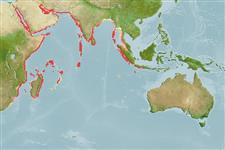>
Acanthuriformes (Surgeonfishes) >
Acanthuridae (Surgeonfishes, tangs, unicornfishes) > Nasinae
Etymology: Naso: Latin, nasus = nose (Ref. 45335); elegans: From the Latin for choice, fine, or nice (Ref. 37792).
More on author: Rüppell.
Environment: milieu / climate zone / depth range / distribution range
Ecologia
marinhas associadas(os) a recifes; intervalo de profundidade 5 - 30 m (Ref. 90102). Tropical; 30°N - 35°S, 30°E - 118°E (Ref. 37792)
Indian Ocean: Red Sea south to Durban, South Africa and east through the islands of the western Indian Ocean to southwestern Indonesia, at least to Bali.
Tamanho / Peso / Idade
Maturity: Lm ? range ? - ? cm
Max length : 45.0 cm SL macho/indeterminado; (Ref. 37792); common length : 35.0 cm TL macho/indeterminado; (Ref. 30573)
Descrição breve
Chaves de identificação | Morfologia | Morfometria
Espinhos dorsais (total) : 6; Raios dorsais moles (total) : 26 - 30; Espinhos anais: 2; Raios anais moles: 27 - 30. Dorsal fin yellow with a blue line at base and a black band above this; anal and pelvic fins dark brown; dorsal and anal fins with a narrow blue margin and black submarginal line; caudal fin yellowish with black upper and lower margins and a submarginal black band posteriorly (Ref. 37792). Caudal fin emarginate with adult males having trailing filaments from each corner (Ref. 37792).
Inhabits coastal and sheltered reef flats in small groups and schools in oceanic locations (Ref. 48637). Also found in rocky bottoms in about 5-30 m (Ref. 90102). Feeds on benthic algae (Ref. 37792).
Life cycle and mating behavior
Maturidade | Reprodução | Desova | Ovos | Fecundidade | Larvas
Randall, J.E., 2001. Surgeonfishes of Hawai'i and the world.. Mutual Publishing and Bishop Museum Press, Hawai'i. 123 p. (Ref. 37792)
Categoria na Lista Vermelha da IUCN (Ref. 130435: Version 2024-2)
Ameaça para o homem
Harmless
Utilização humana
Pescarias: espécies comerciais
Ferramentas
Relatórios especiais
Descarregue XML
Fontes da internet
Estimates based on models
Preferred temperature (Ref.
123201): 24.8 - 28.7, mean 27.1 °C (based on 172 cells).
Phylogenetic diversity index (Ref.
82804): PD
50 = 0.5000 [Uniqueness, from 0.5 = low to 2.0 = high].
Bayesian length-weight: a=0.02344 (0.01004 - 0.05476), b=2.97 (2.77 - 3.17), in cm total length, based on LWR estimates for this (Sub)family-body shape (Ref.
93245).
Nível Trófico (Ref.
69278): 2.0 ±0.00 se; based on food items.
Resiliência (Ref.
120179): Médio, tempo mínimo de duplicação da população 1,4 - 4,4 anos (Preliminary K or Fecundity.).
Fishing Vulnerability (Ref.
59153): Moderate vulnerability (42 of 100).
Nutrients (Ref.
124155): Calcium = 41.6 [21.5, 68.7] mg/100g; Iron = 0.541 [0.290, 0.972] mg/100g; Protein = 18.2 [16.9, 19.4] %; Omega3 = 0.0915 [, ] g/100g; Selenium = 33.6 [17.0, 66.5] μg/100g; VitaminA = 38.8 [8.8, 158.6] μg/100g; Zinc = 1.34 [0.88, 2.05] mg/100g (wet weight);
